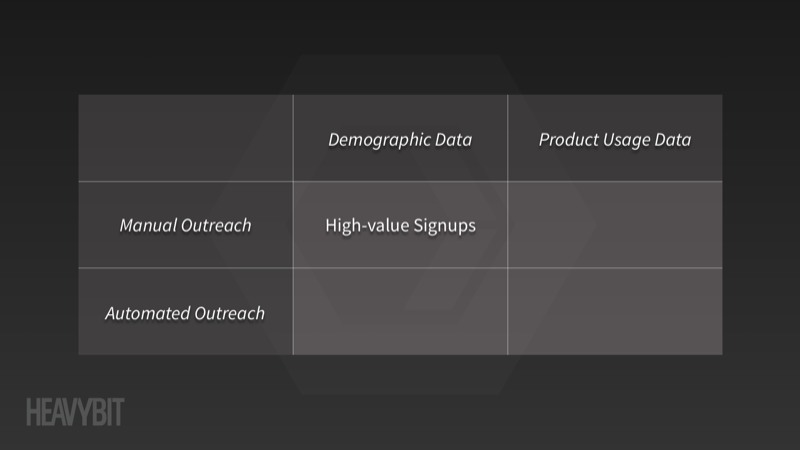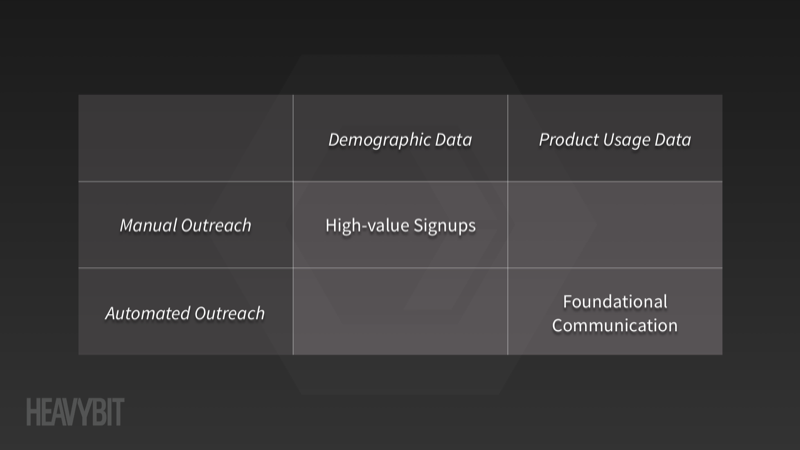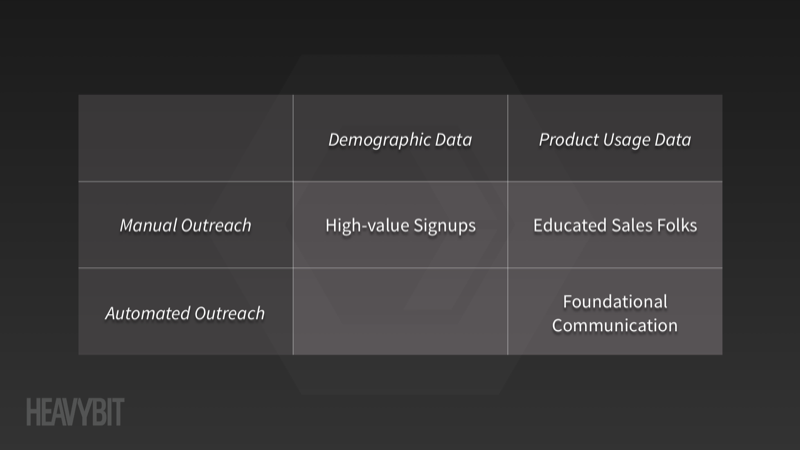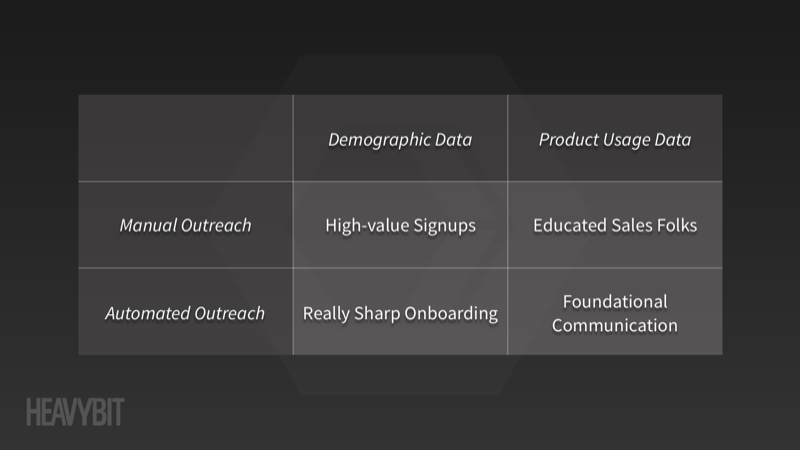Early-stage Customer Communication: Channels and Signals
 Peter Chapman
Peter Chapman
Building a growth engine is about consistently translating signals into actions. The goal is to serve the right information at the right time from the right channel.
Here’s an easy example: if you sign up for a product, chances are you’ll get a free trial of a product; chances are you’ll get an email from them shortly before your trial expires.
Signal: user is one week away from trial expiration.
Action: email them prompting them to upgrade to a paid plan.
Meanwhile, all over the world, SDRs are combing through lists of recent sign-ups for a different kind of customer signal: company demographic. They want to make sure that they’re spending time on people that command buying power and work at relevant companies.
Signal: Customer signs up with an email address from an exciting company and a relevant title.
Action: SDR sends them something vaguely personalized.
These are the two broad kinds of customer signal you should be paying attention to. Product usage data is coming from your own database – it’s everything you know about logins, feature usage, and how users are clicking around on your app. Demographic data is coming from a data augmentation tool and tells you what companies your users work for and what their title is.
In the same vein, you’ve got two simple tools you can use to communicate to customers: you can email them directly (manual communication), or you can tell your email automation system to email them (automated communication).
Those two examples are emblematic of early-stage communications efforts – at many startups, demographic data is exclusively the domain of manual outreach, and product usage data feeds automatic outreach. This is largely the result of the tools available to organizations: salespeople are used to using demographic data to sort through leads, while marketers have a history of keying off product usage data to send campaigns. In this article, we’ll discuss how to use both kinds of data across both channels without getting your wires crossed.
Step 1: Talk to Your Most Important Customers First

First things first: if you’re just starting out, you should care more about who’s on your platform than what they’re doing on your platform. In other words: demographic data matters more than customer usage data.
This is because in the early days of building a growth engine, you don’t have the time to build a sophisticated nurturing machine that ingests a customer’s usage and demographic data and outputs the perfect message designed to nudge them down your funnel. The nudge is going to be a manual effort. That’s fine, because you want to be spending a lot of time talking to your customers. If they get stuck during onboarding, you’re going to fix it by sitting down with them and helping them use your product. In other words, you’ll use demographic data to trigger manual communication.
What this means in the early days is running an augmentation tool on top of your signups, parsing those signups on a regular cadence, and manually crafting notes for the most interesting ones. Later, you’ll build automation that hands high-value over to leads over to sales reps based on the demographic characteristics you’ve found to be the best signal – often company size, revenue, and industry.
Step 2: Your First Automated Communication

There are a couple of high-impact automated emails you should be sending out from the get-go. You want to thank people for signing up and point them to your documentation. You want to warn people when their trial is about to expire. You want to give them a heads up when they’re about to bump against a limit of their current plan.
If you’ve already got this type of automation chugging along, great – you’ve got everything you need for a solid early-stage growth engine. If you want to build an even more sophisticated machine, keep reading.
Step 3: Equipping Your Sales Team

The next step in building out your communication engine is using product usage data to inform your sales team. You want to make sure your sales team is talking to the right accounts, and you want to give them the context they need to have relevant conversations.
The easiest and most important signal to feed your sales team is spend. High-spending customers should have sales reps assigned. I tend to encourage startups to experiment with other signals to feed their sales force. It can be hard to determine what product usage patterns predict growth, but it’s fairly easy to hand your sales team a bunch of new leads and get their feedback on what’s interesting.
Keeping your account managers abreast of how their customers are using the product is useful both for finding ways to grow account spend and mitigate attrition. Sophisticated teams are letting their account managers know about support tickets, error rates, and decreases in utilization on the fly.
Step 4: Really Sharp Onboarding

At some point, manually parsing signups is no longer going to be a viable option, but you’ll still want to triage new signups and personalize outreach. There’s a whole talk about this that you should watch. Segment’s doing a handful of things I really like: they’re sending emails that are personalized based on both industry and title, and their onboarding flow adapts to allow high-value customers to opt-in to a fast track.
My favorite conversations at Heavybit are inevitably the times when I get to talk to one of our founders about their funnel and map out what the next step is in building their revenue engine. If you want help building yours, feel free to reach out – I’d love to talk.
Subscribe to Heavybit Updates
You don’t have to build on your own. We help you stay ahead with the hottest resources, latest product updates, and top job opportunities from the community. Don’t miss out—subscribe now.
Content from the Library
The Role of Synthetic Data in AI/ML Programs in Software
Why Synthetic Data Matters for Software Running AI in production requires a great deal of data to feed to models. Reddit is now...
Data Council 2025: The Foundation Models Track with Dr. Bryan Bischof and Tom Drummond
Heavybit is thrilled to be sponsoring Data Council 2025, and we invite you to join us in Oakland from Apr 22-24 to experience 3...
Data Council 2025: The Data Science & Algorithms Track with Sean Taylor and Jesse Robbins
Heavybit is thrilled to be sponsoring Data Council 2025, and we invite you to join us in Oakland from Apr 22-24 to experience 3...